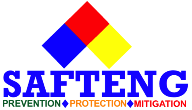What is the relationship between reportable quantities (RQs) and threshold planning quantities (TPQs)?
The reportable quantity (RQ) that triggers emergency release notification (Section 304) was developed as a quantity that when released, poses a potential threat to human health and the environment. The RQs were developed using several criteria, including aquatic toxicity, mammalian toxicity, ignitability, reactivity, chronic toxicity, potential carcinogenicity, biodegradation, hydrolysis, and photolysis (50 FR 13468, April…...
